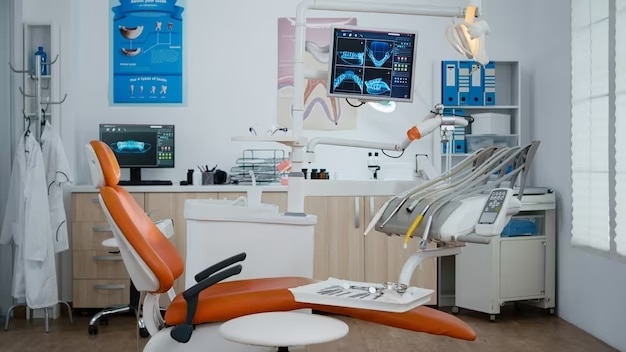
Incorporating Technology Into Your Dental Office Design
As technology continues to evolve, so should your dental practice. Incorporating the latest advancements into your office design can not only enhance the patient experience but also improve the efficiency and productivity of your staff. From digital X-rays to virtual consultations, there are countless tools available that can take your practice to new heights. In this blog post, we’ll explore the benefits of integrating technology into your dental office design and provide tips on how to choose the right solutions for your specific needs. So buckle up and get ready to transform your practice with cutting-edge tech!
What Are The Benefits Of Incorporating Technology Into Your Dental Office Design?
In today’s ever-evolving world, technology has become an integral part of our lives. The same applies to the dental industry as well. Incorporating technology into your dental office design can provide a plethora of benefits that will not only make your practice more efficient but also improve patient satisfaction.
One of the primary benefits of incorporating technology is increased accuracy and precision in diagnosis and treatment planning. With advanced imaging systems such as cone beam computed tomography (CBCT) scans, dentists can get detailed 3D images of a patient’s teeth, jawbone, and surrounding tissues. This allows for more accurate diagnosis and helps in creating personalized treatment plans tailored to each patient’s needs.
Another benefit is improved efficiency and productivity in day-to-day operations. For instance, digital records management software eliminates the need for manual record-keeping, saving time and reducing errors significantly. Additionally, intraoral cameras enable dentists to capture high-quality images easily; this enhances communication between dentist-patient leading to better understanding & trust.
Moreover, modern tools like CAD/CAM (Computer-Aided Design/ Computer-Aided Manufacturing) allow dentists to create custom restorations seamlessly on-site without needing outside labs or extended waiting periods for lab results.
Lastly, enhanced patient satisfaction with shorter wait times & quicker diagnoses greatly impacts their overall experience at your practice leading them returning back again!
Implementing technology into dental practices streamlines processes while improving the overall quality of care provided – making it an essential investment!
How Can You Choose The Right Technology For Your Practice?
Choosing the right technology for your dental practice can be overwhelming, especially with all the options available in today’s market. However, taking time to evaluate your needs and goals as a practitioner can help you make an informed decision.
- Firstly, consider what areas of your practice would benefit most from technological improvements. Are you looking to improve patient experience through digital appointment scheduling or online forms? Or maybe you’re seeking more efficient ways to manage patient records and communications.
- Next, research different software solutions that offer these features and compare their functionality and user-friendliness. Look for reviews from other dental professionals who have used these programs before.
- It’s also important to consider the compatibility of any new technology with your current systems. Will it integrate seamlessly with existing hardware and software infrastructure? Will staff need additional training to effectively use it?
- Take into account the cost of implementing new technology into your practice. Compare pricing plans across different providers and weigh the potential return on investment against upfront costs.
Ultimately, choosing the right technology requires careful consideration of multiple factors specific to each individual practice. By doing a thorough research and keeping in mind both short-term benefits and long-term implications, practitioners can make informed decisions that best serve their patients’ needs while improving overall efficiency in their office operations.
What Are Some Common Dental Office Technologies?
Dental technology has come a long way over the years, and there are now a variety of tools and devices that can help make your dental practice more efficient, effective, and comfortable for patients. Here are just a few examples of some common dental office technologies that you might consider incorporating into your practice.
- One important area is digital imaging technology. With digital X-rays and intraoral cameras, you can capture highly detailed images of teeth, gums, and other oral structures in real time. This allows you to diagnose problems more accurately and quickly than ever before.
- Another useful tool is CAD/CAM software which uses computer-aided design (CAD) to create precise models of dental restorations such as crowns or bridges. The computer then guides the milling machine through Computer-Aided Manufacturing (CAM) creating accurate restorations efficiently with explicit materials matching the tooth shade making it look like an original tooth.
- Laser dentistry is another exciting development in recent years that offers many benefits including less pain during procedures because no drilling machines are involved; reduced healing times for patients due to minimized trauma compared with traditional methods; improved precision when working on delicate areas inside the mouth where precision matters most!
Introducing these types of technologies into your dental office design will not only improve patient experience but also boost efficiency levels by streamlining processes while ensuring top-notch care delivery!
The Bottom Line
Incorporating technology into your dental office design can bring numerous benefits, from improving patient experience and satisfaction to increasing productivity and revenue. However, it’s important to choose the right technologies that fit your practice’s unique needs and goals.
When planning your dental office design, take the time to research and evaluate different technologies such as digital imaging systems, electronic health records software, patient communication tools, and more. Consider factors like cost, ease of use, compatibility with existing equipment or systems, and potential ROI.
By investing in the right technologies for your dental practice and incorporating them thoughtfully into your office layout and workflow processes, you can create a modernized environment that enhances both patient care quality and business efficiency.
So why not start exploring which technologies could help take your dental practice to new heights? With careful planning and implementation strategies in place, you may be surprised at how much value they can add.

